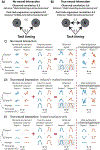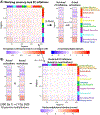Task activations produce spurious but systematic inflation of task functional connectivity estimates
- PMID: 30597260
- PMCID: PMC6422749
- DOI: 10.1016/j.neuroimage.2018.12.054
Task activations produce spurious but systematic inflation of task functional connectivity estimates
Abstract
Most neuroscientific studies have focused on task-evoked activations (activity amplitudes at specific brain locations), providing limited insight into the functional relationships between separate brain locations. Task-state functional connectivity (FC) - statistical association between brain activity time series during task performance - moves beyond task-evoked activations by quantifying functional interactions during tasks. However, many task-state FC studies do not remove the first-order effect of task-evoked activations prior to estimating task-state FC. It has been argued that this results in the ambiguous inference "likely active or interacting during the task", rather than the intended inference "likely interacting during the task". Utilizing a neural mass computational model, we verified that task-evoked activations substantially and inappropriately inflate task-state FC estimates, especially in functional MRI (fMRI) data. Various methods attempting to address this problem have been developed, yet the efficacies of these approaches have not been systematically assessed. We found that most standard approaches for fitting and removing mean task-evoked activations were unable to correct these inflated correlations. In contrast, methods that flexibly fit mean task-evoked response shapes effectively corrected the inflated correlations without reducing effects of interest. Results with empirical fMRI data confirmed the model's predictions, revealing activation-induced task-state FC inflation for both Pearson correlation and psychophysiological interaction (PPI) approaches. These results demonstrate that removal of mean task-evoked activations using an approach that flexibly models task-evoked response shape is an important preprocessing step for valid estimation of task-state FC.
Keywords: Computational modeling; Functional connectivity; Method validation; Networks; fMRI.
Copyright © 2019 Elsevier Inc. All rights reserved.
Figures








Similar articles
-
The Functional Relevance of Task-State Functional Connectivity.J Neurosci. 2021 Mar 24;41(12):2684-2702. doi: 10.1523/JNEUROSCI.1713-20.2021. Epub 2021 Feb 4. J Neurosci. 2021. PMID: 33542083 Free PMC article.
-
Quantifying Differences Between Passive and Task-Evoked Intrinsic Functional Connectivity in a Large-Scale Brain Simulation.Brain Connect. 2018 Dec;8(10):637-652. doi: 10.1089/brain.2018.0620. Brain Connect. 2018. PMID: 30430844 Free PMC article.
-
Activity flow over resting-state networks shapes cognitive task activations.Nat Neurosci. 2016 Dec;19(12):1718-1726. doi: 10.1038/nn.4406. Epub 2016 Oct 10. Nat Neurosci. 2016. PMID: 27723746 Free PMC article.
-
Interpreting temporal fluctuations in resting-state functional connectivity MRI.Neuroimage. 2017 Dec;163:437-455. doi: 10.1016/j.neuroimage.2017.09.012. Epub 2017 Sep 12. Neuroimage. 2017. PMID: 28916180 Review.
-
Scanning the horizon: towards transparent and reproducible neuroimaging research.Nat Rev Neurosci. 2017 Feb;18(2):115-126. doi: 10.1038/nrn.2016.167. Epub 2017 Jan 5. Nat Rev Neurosci. 2017. PMID: 28053326 Free PMC article. Review.
Cited by
-
Multitask brain network reconfiguration is inversely associated with human intelligence.Cereb Cortex. 2022 Sep 19;32(19):4172-4182. doi: 10.1093/cercor/bhab473. Cereb Cortex. 2022. PMID: 35136956 Free PMC article.
-
High-accuracy machine learning techniques for functional connectome fingerprinting and cognitive state decoding.Hum Brain Mapp. 2023 Nov;44(16):5294-5308. doi: 10.1002/hbm.26423. Epub 2023 Jul 27. Hum Brain Mapp. 2023. PMID: 37498048 Free PMC article.
-
Combining Multiple Functional Connectivity Methods to Improve Causal Inferences.J Cogn Neurosci. 2021 Feb;33(2):180-194. doi: 10.1162/jocn_a_01580. Epub 2020 May 19. J Cogn Neurosci. 2021. PMID: 32427070 Free PMC article.
-
Intrinsic reward circuit connectivity profiles underlying symptom and quality of life outcomes following antidepressant medication: a report from the iSPOT-D trial.Neuropsychopharmacology. 2021 Mar;46(4):809-819. doi: 10.1038/s41386-020-00905-3. Epub 2020 Nov 23. Neuropsychopharmacology. 2021. PMID: 33230268 Free PMC article. Clinical Trial.
-
Differences between subclinical attention-deficit/hyperactivity and autistic traits in default mode, salience, and frontoparietal network connectivities in young adult Japanese.Sci Rep. 2023 Nov 13;13(1):19724. doi: 10.1038/s41598-023-47034-7. Sci Rep. 2023. PMID: 37957246 Free PMC article.
References
-
- Barch DM, Burgess GC, Harms MP, Petersen SE, Schlaggar BL, Corbetta M, Glasser MF, Curtiss S, Dixit S, Feldt C, Nolan D, Bryant E, Hartley T, Footer O, Bjork JM, Poldrack R, Smith S, Johansen-Berg H, Snyder AZ, Van Essen DC, Consortium, F.T.W.-M.H., 2013. Function in the human connectome: Task-fMRI and individual differences in behavior. NeuroImage 80, 169–189. doi:10.1016/j.neuroimage.2013.05.033 - DOI - PMC - PubMed
Publication types
MeSH terms
Grants and funding
LinkOut - more resources
Full Text Sources
Medical

